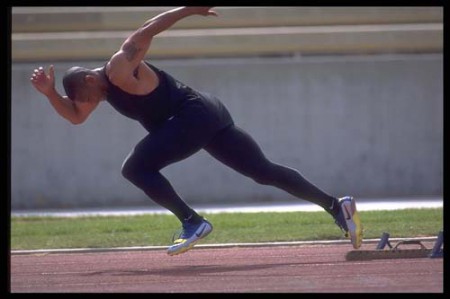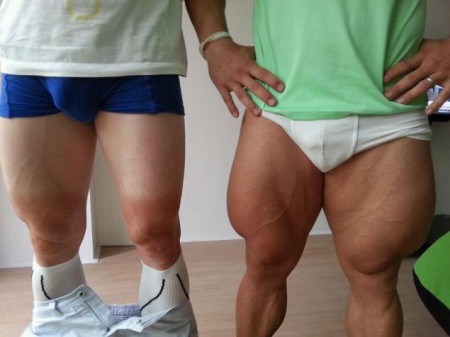Life is spinning out of control,
seems the whole world is out to get you,
Everything is wrong, nothing seems right-eh.
…
But you can’t let it bring you down,
No you’ve got to fight-ehhhhh…
— Baseketball
I’m really good at pointing out things that are wrong, so let’s get started.
1. Nobody in this video can string a sentence together confidently. At one point Maurice Greene says that the coach is going “to facilitate us on the weightroom”. Huh??? Then he says, “Here we have Montel Douglas who is the British national record holder…for Great Britain…and shit.” I added the last part because they undoubtedly had to edit that part out. Then the coach makes up his sentence as he goes along as if he’s never had to think about it before. Then he says the squat is “important for a track athlete to simply create force into the ground”. To clarify, we don’t summon force out of thin air like a demon, we apply force into the ground so that Newton’s third law occurs (equal and opposite reaction) to move. I’m not expecting this explanation, but I am expecting correct terminology when you’re a supposed expert.
I could keep going. “We go a hip-width distance” — of what? “We feel that halfway to a quarter is deep enough,” — sharing your feelings is not a way to prove why to do something.
Sure, even I have bad days with communicating, but this was terrible. What is Montel the world record holder of? Why should track athletes lift weights? What is this squat movement accomplishing? Why is this “new” movement beneficial?
2. “What better exercise to load the lower body than the barbell squat,” and then he hardly loads the body by doing a partial rep. And wasn’t this the reason that Maurice stated that they didn’t want to go deeper?
3. “Puts a lot of stress on yo body, creates injuries…and shit”. If you perform the squat like Maurice Greene, who is labeling himself as the expert, then yes, they can be injurious. In fact, decent squats can be injurious if regular mobility work isn’t performed. This is why a proper squat is done with the hip going below the knee so that it trains the lower body joints and musculature through a full range of motion. This is also why proper foot attire is worn to increase the efficiency and subsequently the safety. Remember that lifting shoes have the slight heel increase, the non-compressible sole, the meta-tarsal straps, and the wider sole base to help solidify the articulation of the athlete to the ground so that they can properly apply force. Furthermore, lifting shoes help utilize the body’s mechanics more efficiently to distribute force evenly across the thighs and hips regardless of anthropometry. A belt will only increase all of this efficiency by increasing the intra-abdominal and thoracic pressure, increasing the stability of the trunk which will not only improve the transmission of force (AKA performance), but help protect the spine by improving the pneumatic “brace” against the anterior portion of the spine.
4. Since when do sprinters run with a short range of motion? I haven’t watched sprinting in this year’s Olympics, but my understanding is that good sprinting takes the hips through, or nearly through, a full range of motion. Wouldn’t we want to train all of this musculature through a full, albeit safe, ROM so that we are as strong as possible? Even if this wouldn’t help us apply force, which it does, it would at least strengthen the musculature through a full ROM to help reduce the chance of injury since the structures adapt to handling greater forces.

Oh, that’s weird. Here’s a pic of Maurice Greene with both of his hips near or at their limit of hip flexion and extension.
5. I could understand an argument that full ROM squats may be too stressful for inclusion in a sprint program in the same way that I say deadlifts are too stressful for certain stages of programs (i.e. for Oly lifters, soldiers, or football players), but that’s not the argument here. Furthermore, even if it was, the sprint athlete most likely has a periodized approach to their training year, especially if they are peaking for World Championships or the Olympics. Therefore they’d be changing the volume, intensity, and frequency of their squatting. Also, they would, at this point, be adapted to handling both squatting and sprinting during the week because they have been progressed into it.
6. I’m pretty sure that when I was younger I read an article in Men’s Health (or similar crappy magazine) that Maurice Greene was squatting 315 for sets of 10 in his training. I’ve seen reports that he squatted above 500. Even if it wasn’t Maurice in the mag, there are many documented reports of him squatting decently heavy to prepare for his sprinting. We can assume he at least went to the depth he showed in the above video. Wouldn’t that show us that it worked? He held the world record in the 100m at 9.79s, he won two gold medals, a silver, and a bronze. He won five world championships as well as one indoor world championship. Can we not say that squatting supported all of this? When he won his gold medals at the 2000 Games, he was 26. In 2001, he started having issues with injuries, but still won the silver and bronze in the 2004 Games at 30 years old. He eventually retired in 2005 at the age of 31. His first major international tournament was in 1995 when he was 21 years old and he failed to make the Olympic team the following year. This means that he had at least 10 years of hard, elite-level training. We can assume that he was training for at least 3 years before his first major tournament, putting his highly demanding competitive years at 13. He probably ran track in high school, but we’ll ignore those four possible years.
What does all of this mean? He was very accomplished, but as he got older, his body broke down. This happens to everyone. There isn’t enough performance enhancement drugs to account for getting older (Greene said he bought PEDs, but allegedly didn’t use them). 30 years old is ancient in demanding professional sports. Most guys are out of the NFL before they are 28. It’s not that crazy to assume that his body couldn’t keep up with the demands of elite level sprint training anymore, and this is almost certainly what happened. Sure, he could have gotten hurt squatting, but he was “getting old”. 30 isn’t old, all things considered, but it is for Olympians in a high demanding sport. Sorry Maurice, just because you regret having to retire and don’t accept the fact that you can’t retain physical prowess forever doesn’t meant that full squats are bad or injurious. And we aren’t even taking the fact that you don’t squat efficiently into consideration. It’s hard for me to take a guy seriously who squatted his whole life, had an amazing career, and then campaigns against doing them.
7. Track coaches do some weird things. Barry Ross has his sprinters deadlift the bar to the knees, then drop it to the floor. This removes the eccentric portion which apparently helps reduce injuries. It’s a “halting deadlift”, which is typically really fucking useless, but in this case I can see the applicability because it strengthens the concentric action of the hamstrings, but more importantly strengthens the back and hip musculature to stabilize everything for sprinting. I explain this concept in my seminars, but if your hips are not held in place during sprinting, then you are losing out on some arbitrary amount of force you area applying to the ground with each foot strike.
I can understand the above example for a specific type of athlete with a specific mechanical and structural demand for a single modality athletic event. I concede to the fact that something weird may be applicable to a very specific athlete. However, the above example is supported by anatomy, mechanics, and logic; the quarter squat is not. It mostly loads the knee extensors through a few degrees of motion. I guess it looks like that stupid VMO exercise people use while standing on a block. I’m not against using weird, yet specific assistance exercises to build up an area that can enhance total movement. But don’t label it as something that is the holy grail or the primary strengthener. In other words, don’t use a cute, gimmicky exercise and sell it as the “main thing to do”. That’s the only way that I could see the quarter squat being used, but even then it doesn’t make sense from an anatomical, mechanics, or logical perspective.
8. The athlete can be good in spite of stupid exercises. There’s a guy who trained in the gym in Texas. He is a white guy of average height and weight and played collegiate football. He is a freak. He has at least a 40 inch vertical and would be squatting 500 for reps within several minutes of walking in the gym. In basketball shoes. He didn’t really listen to coaching very well and just did his own thing, but he was strong as hell doing it his way. He reportedly squatted 700 pounds in college and was the quarterback.
My point? In spite of not having completely sound mechanics, this guy was strong and powerful. And he’s not an Olympian or an elite athlete. Imagine someone who is not only gifted physically, but has the drive and determination to be great. They are truly a freak in the average person’s eyes, capable of outstanding performances. People like this can and will make progress in spite of inefficient training techniques or programming because they have such a great genetic potential and an iron will to work hard.
We see this all of the time with crappy strength programs in collegiate, even high school, settings that produce beasts that can bench 500 pounds and squat 600+ with little to no training. It’s not absurd to have an elite athlete do a stupid, meaningless exercise and they will improve nonetheless. Some strengthening is better than no strengthening, but that doesn’t mean it’s right.
This means that regardless of ability, a coach should do his job to strengthen the relevant musculature through full ranges of motion, maintaining or improving the mobility of the athlete, and not only not injure the athlete, but train them so that they are harder to hurt. By these qualifications, the coach in the video failed.
At least there are some Olympians who understand the power of squats.

